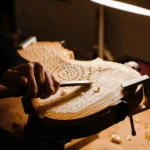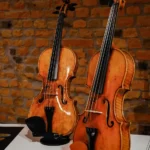Gagliano Family of Violin Makers
Back to BlogGagliano Family of Violin Makers
In the history of violin-making in Naples, the Gagliano Family is a prominent name. You will be surprised to know that twelve members of the Gagliano Family passed through the violin-making legacy onto five generations that started with Alessandro Gagliano, then Carlo and Nicolo I Gagliano, ending with Vincenzo and Alberto Gagliano.
By now, we are sure you must be eager to know about the Gagliano family of violin makers, and so are we therefore the following blog will enlighten you regarding Naples and the family who have left an influential mark in the history of violin makers through their artist craftsmanship.
The World Capital Of Music: Naples
Before we delve into the details of the Gagliano family of violin makers, we should first understand why Naples was the world capital of music.
Traveling back to the 17th century, Charles de Brosses, the French politician, referred to Naples as the world’s capital of music. The remark emerges as direct feedback displaying the extravagant and vibrant musical history the city comprises and the pivotal role the place has played in the progress of Western European music.
The Gagliano Family Dynasty
During the 18th century, a massive number of instruments were crafted in Naples. The making reveals that the Neapolitan economy flourished through it, and the craftsmen on the job must have faced no financial barriers at the time. On the other hand, repair work was also in demand. The archives in the metropolitan area carry records of the expenditure budget spent on the conservatory, which included concurrent repair work executed by makers of organs, harpsichords, wind instruments, and string instruments.
The conservatories had hired other string instrument makers, who worked day and night for the conservatories. But when anyone sees the records from the archives it becomes evident that the majority of the string instrument services were offered by members of the Gagliano family. The production remains consistent with the interpretation that around 1700, the overall Gagliano monopoly rose as they had conquered the art of Neapolitan violin-making.
The Gagliano dynasty commenced with Alessandro Gagliano (1665-1732), passing forward to Nicolo I Gagliano (1710-1785), Gennaro Gagliano (1705-1790), and Nicolo I’s son Ferdinando Gagliano (1738-1804).
The Gagliano family is a celebrated lineage of Italian violin makers with a legacy dating back to the 18th century. The family’s craftsmanship has left an indelible mark on the world of violin-making. The Gagliano family’s enduring presence in the world of violin making, spanning nearly two centuries, contributed to Naples becoming a significant hub for violin production. Their instruments, each crafted with a unique style, catered to evolving customer preferences and maintained a reputation for quality and affordability.
Alessandro Gagliano
Alessandro Gagliano was the head of the Gagliano Family, the pioneer of violin-making in Naples, and the first to be known as a Neapolitan maker. Little is known about his debut in violin making; historians and biographers believe that he, traveling north to Cremona, learned from the great masters of that time, such as Nicoló Amati and Antonio Stradivari.
By 1695, Naples invited Alessandro back, and now the brains behind violin making were deeply enriched with violin knowledge. Upon his return, Alessandro worked on establishing the Neapolitan school and was the founder of it. Alessandro Gagliano proved himself to be an excellent judge of wood when the material had to be selected to carve out the violin, and he could easily figure out which wood would steal the show in terms of beauty and tone. If one asks about the tonal quality of the instruments he made, then the answer is that they were pretty euphonious on the G and D strings.
The legacy of violin-making passed on to the new generation, as Alessandro had many sons, grandsons, and descendants who inherited the skill. The history is vast, extending into the 20th century.
Nicolo I Gagliano
The successor of the Gagliano family of violin makers was Nicolo I Gagliano. He has received the title of being the most influential violin maker of the Gagliano family. Like his father, Nicolo had understood how the legendary Amati and Stradivari kept themselves apart from the other violin makers of Naples. The unique style of the mentors permeated the concepts of classical Cremonese models. Nicolo adopted them so well that when he blended the same methods in violin making, people mistook his work, thinking that these violins were also created by the masters Amati and Stradivari.
He and his brother Gennaro produced some of the most in-demand violins of the Gagliano family. After that, his son Giuseppe revealed a keen interest in collaborating with him in violin-making. Nicola and Gennaro introduced the instrument that uses beech and paper for perfect purfling. The hard work ended up becoming an authentication mark of the Gagliano family and the making of the Neapolitan violin.
It is sad to see that scholars overlooked Nicolo’s efforts because his work looked so real to that of Amati and Stradivari that many perceived that it was their creation and not Nicolo’s. Still, history does not deny that he was one of the greatest violin makers in the Gagliano family. He will keep receiving the recognition he deserves for the violins he made.
Gennaro Gagliano
Nicolo’s brother, Gennaro Gagliano, enjoys a reputation that is higher in rank than his brother’s. According to the experts, Gennaro was known to be one of the greatest luthiers in the family. He made some quality violins that exceeded expectations and kept his father’s name alive in the end.
Needless to say, both Gennaro and Nicolo were inclined to craft, absorbing inspiration from Amati and Stradivari. His style did not reflect his father’s creativity; instead, he chose to idolize Stradivari. He made violins, adding personal touches, and showed clear refinement in terms of texture and color that were softer and richer than those of other violin makers of the family. Besides that, he incorporated the F-holes pattern and enlarged the curves that led to the upper and lower eyes. The body of the violin was designed with a bulge in the area that led to the corners. He beautifully merged the Cremonese violin-making methods that give the typical ‘’net’’ figure. The cellos he made based on Stradivarian models are much in demand by instrument string enthusiasts.
If we talk about Gennaro’s varnishing, then there is a striking difference between his brother’s and his varnishing. Nicola made the most out of a deeper, red-orange shade. Gennaro was fond of orange-yellow, which set the benchmark of becoming the standard violin in the family as they proceeded towards the last years of the 18th century.
The Fratelli Gagliano
Giuseppe, Giovanni, and Antonio are Nicolò Gagliano’s sons, Alessandro Gagliano’s grandsons, and Gennaro’s nephews. Giuseppe displayed exceptional talent, while Antonio often collaborated with his brother, and Giovanni’s instruments were somewhat rare. The Fratelli Gagliano, Giuseppe, Antonio, and Giovanni, along with their older brother Ferdinando, contributed to the family workshop’s rich heritage, producing instruments that are now treasured rarities.
Ferdinando Gagliano
Of all the family members, Ferdinando Gagliano is believed to be the most productive member of the 3rd generation of the family. In this period, through the second half of the 1700s, the family consolidated its style and matured its approach into what is defined today as the Neapolitan School of violin making. Ferdinando and his brothers were trained in one of the world’s finest violin-making workshops. But unlike his brothers, Ferdinando does not seem to have learned his craft from his father, Nicolò. In fact, the influence of his uncle Gennaro in his style, models, and fine details is undeniable. All leads to believe that he pursued, as much as possible, a solo career, with some independence of the family business, eventually coworking with his brothers.
Violin-making has an extremely rich history that involves prominent families like the Gagliano family. Alessandro showed his immense dedication and sincerity in crafting the skill of inventing some of the greatest and most expensive violins under the mentorship of Amati and Stradivari, which was passed on to his sons Nicolo and Gennaro. They further evolved the violin-making, taking inspiration from the Cremonese masters.
Please scroll down to see some violins from the Gagliano Family that are currently available for sale or have passed in our collection.
VIOLIN BY FRATELLI GAGLIANO, NAPLES, C.1800
This violin shows the handcrafting of the great makers of the family third generation, who consolidated and matured the characteristics and style later known as the Classic Neapolitan School. The small, delicate scroll has an elongated peg-box shape, flatter arching, and a strong, resolute f-holes design.
VIOLIN BY FERDINANDO GAGLIANO, NAPLES, 1771
Covered with a lovely golden varnish, this Ferdinando Gagliano violin presents most of the typical characteristics of the Neapolitan school that was consolidated by his own generation: The curved shape of the pegbox, the delicate and small design of the scroll, and the Stradivari model of the body and f-holes, with full but elegant and mild arching.
VIOLIN BY GENNARO GAGLIANO, NAPLES, C. 1751
This rare and exceptional instrument exhibits the versatile and spontaneous approach of Gennaro Gagliano and his profound knowledge of the great Cremonese tradition. It shows some peculiar details that precisely represent the work of Gennaro Gagliano. From our point of view, this instrument’s most special feature is the strong and precisely sculpted arching of amatisè inspiration.









